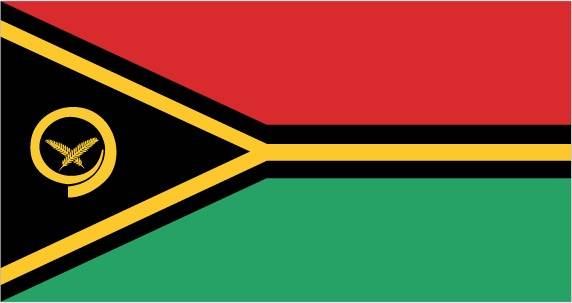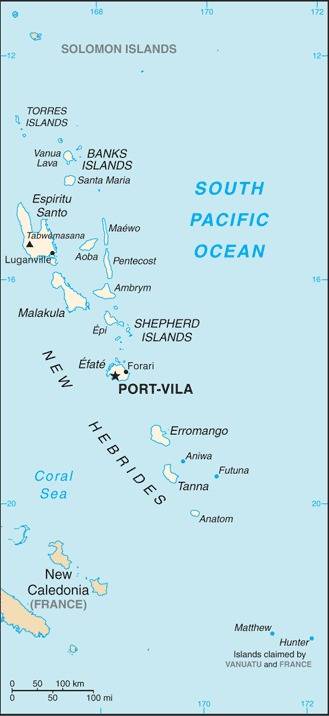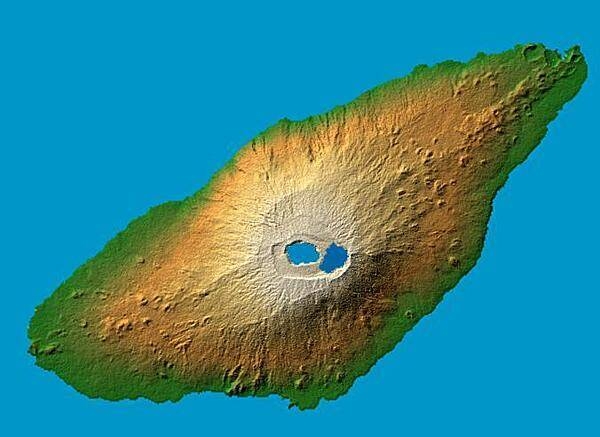53 Vanuatu

Two equal horizontal bands of red (top) and green with a black isosceles triangle (based on the hoist side) all separated by a black-edged yellow stripe in the shape of a horizontal Y (the two points of the Y face the hoist side and enclose the triangle). Centered in the triangle is a boar’s tusk encircling two crossed namele fern fronds, all in yellow. Red represents the blood of boars and men, as well as unity, green the richness of the islands, and black the ni-Vanuatu people. The yellow Y-shape – which reflects the pattern of the islands in the Pacific Ocean – symbolizes the light of the Gospel spreading through the islands. The boar’s tusk is a symbol of prosperity frequently worn as a pendant on the islands. The fern fronds represent peace.
Flag courtesy of the CIA World Factbook

Map courtesy of the CIA World Factbook

Periodically active volcano Mt. Manaro is the dominant feature in this shaded relief image of Aoba (Ambae) Island, part of the Vanuatu Archipelago located 2,250 km (1,400 mi) northeast of Sydney, Australia. The 1,496 m (4,908 ft) high Hawaiian-style basaltic shield volcano features two lakes within its summit caldera, or crater. Two visualization methods were combined to produce the image: shading and color coding of topographic height. The shade image was derived by computing topographic slope in the northwest-southeast direction, so that northwest slopes appear bright and southeast slopes appear dark. Color coding is directly related to topographic height, with green at the lower elevations, rising through yellow and tan, to white at the highest elevations.
Photo courtesy of the CIA World Factbook
Government
According to Britannica, under the terms of the 1980 constitution, the president, who serves as head of state in Vanuatu, is elected to a five-year term by an electoral college made up of the unicameral Parliament and the presidents of the Regional Councils. Members of Parliament are elected to four-year terms on the basis of universal franchise. Parliament elects the chief executive, the prime minister, from among its members; the prime minister then appoints a Council of Ministers. The constitution also provides for a National Council of Chiefs (Malvatumauri), composed of elected “custom chiefs,” which advises the government on matters relating to custom and tradition. Provincial authorities are responsible for local governmental functions.
The Supreme Court is the ultimate judicial arbiter of both civil and criminal matters. There are also a court of appeal and magistrates’ courts, and island courts may be established by warrant to rule on land disputes.
Civil / National Aviation Authority (CAA/NAA)
The Civil Aviation Authority of Vanuatu is a statutory body under the Ministry of Infrastructure and Public Utilities which oversees all aspects of the Republic of Vanuatu’s civil aviation system including regulating access to the 30+ airports and landing which provide critical aviation infrastructure to the country’s 65+ inhabited islands. CAAV’s mandated purpose is to ensure the safety of all people who engage in, benefit from or otherwise may be impacted by civil aviation within the nation’s sovereign airspace. This being the case, CAAV is also the primary regulator of autonomous flying drone operations within Vanuatu airspace.
The Pacific Aviation Safety Office (PASO) is an international organization providing quality aviation safety and security service for Member States in the Pacific.
PASO is the sole international organization responsible for regional regulatory aviation safety oversight service for the 10 Pacific States who are signatories to the Pacific Islands Civil Aviation Safety and Security Treaty (PICASST).
The current PICASST signatories are the Pacific nations of Cook Islands, Kiribati, Nauru, Niue, Papua New Guinea, Samoa, Solomon Islands, Tonga, Tuvalu, and Vanuatu. Associate Members of PASO are Australia, Fiji and New Zealand. Government representatives from these nations make up the PASO Council.
Airspace
SkyVector – Google Maps – ADS-B Exchange
ICAO countries publish an Aeronautical Information Publication (AIP). This document is divided into three parts: General (GEN), En Route (ENR) and Aerodromes (AD). ENR 1.4 details the types of airspace classes they chose to adopt from classes A through G. Vanuatu AIP
Drone Regulations
There has been much discussion and potentially misleading information recently on social media around flying drones in Vanuatu, with a great deal of speculation and assumption being shared.
Acting Director, Mrs Naiany Karu Civil Aviation Authority Vanuatu (CAAV) says that “CAAV supports the use of drones in Vanuatu, but wants everyone to make sure they are used safely. While a small drone may seem harmless, it is still an aircraft with the potential to cause damage to other aircraft as well as people and property on the ground or on the water. CAAV is responsible for setting the standards that balance the risks of operating drones in Vanuatu to achieve reasonable levels of safety that align with manned aviation.”
“To support the safe use of drones in Vanuatu, the CAAV is developing regulations, to make it clearer who can fly what, when and where. These regulations will be circulated for a second round of consultation shortly.”
“Until the specific rules are established, drone operators need to know that they are ‘pilots’ and that they are flying ‘aircraft’ and must at all times obey the aviation regulations of Vanuatu.” The pilot in command of an aircraft (a drone) is responsible for the safe operation of the aircraft in flight and is responsible for compliance with all relevant prescribed requirements (CAA Act 2006 S13(a) and (c)). Further, a person operating an aircraft in a careless, dangerous, or not properly approved manner can be fined (fines of up to 800,000VUV for individuals, CAA Act Part 6 Div 1).
Mrs Karu also points out that it is not just CAAV which has responsibilities for how, where and when drones can be operated. To be safe, a drone operator also needs the approval of the landowner (or property manager) for the land they wish to fly over; which might include Municipalities, the Harbour Master and Private landowners. In some instances, where a drone is fitted with a camera, there may be other agency approvals required for cultural, privacy and security requirements.
Rather than forbidding the use of drones, the former Director Joseph Niel, in 2016, sought help from interested parties to find alternative means of compliance for drone operators to help them to learn how to, and facilitate, safer operations.
Mrs Karu says that “CAAV has relied entirely on voluntary support to share information around drone operations to date, and we appreciate that there are committed aviators out there willing to help build this industry safely.” In particular, Mrs Karu notes that “the VKS website www.drone.vu is one way volunteers have stepped up. This website manages VKS media requirements for drones, while also supporting drone operators to understand the rules and assists in working with people to ensure that they are operating safely (or if they need to approach CAAV for more detailed assessment).”
Mrs Karu cautions that some of the social media advice circulating recently contains false and misleading information and could be risky to follow. Also, the overseas websites and apps being shared are often not funded to provide valid information for Vanuatu and could be dangerous to rely on. Mrs Karu does refer drone pilots to the Drone Log Book service (also available with a Drone.Vu registration) as a useful tool to drone pilots to keep adequate records of their flights. Until the regulations come into being, CAAV recommends following world’s best practice. This will ensure that you remain compliant and safe.
Mrs Karu emphasizes that the standard operating conditions currently approved by CAAV are:
• “All operations must be in Visual Line of Sight of the operator, i.e. you must have eyes on the drone and the surrounding airspace at all times
• Stay under 400ft (120m)
• Stay out of the way of manned aircraft
• Do not fly over buildings or people
• Remain more than 30 m away from other people not involved with the operation at all times
• Only fly during daytime
• Have the landowner’s/property manager’s permission
• Stay more than 4km away from ANY airport
• Only use drones that weigh less than 25kg”
Mrs Karu reminds drone owners that if they want to do any flying that is outside of these conditions, they will need to talk to CAAV to find out if they can, and how to, make sure they keep their operation safe and compliant.
Mr Manfred Veremiato, an Airworthiness Officer with the CAAV, says that “local experience in Vanuatu is also important, such as knowing to:
• Keep clear of the Helicopter Pontoon at Port Vila harbour (in fact any flights over the harbour need both the Harbour Masters and Vanuatu Helicopters approvals)
• Remember that flying on Mystery Island is unsafe, as the whole Island is an airport.
• Keep clear of Cruise Ships
• In Port Vila, stay clear of the Port Vila TMA (https://maps.vu/airspace/port-vila-tma)
• Be mindful that winds can be unpredictable, or stronger around mountains and cliffs
• Be respectful of cultural requirements and others privacy”
CAAV Says “Fly Safe and Respectfully – Safe and Secure Skies Prosper Vanuatu”
Advanced Air Mobility (AAM)
Short Essay Questions
Question 1
You have been hired by a Drone Startup Company. Your boss has immediately assigned this job to you.
They need you to prepare a one-page memo detailing the legalities of using a drone in Vanuatu.
They need you to mention any national laws and local ordinances.
They specifically want to know what airspace you will be operating in and whether or not you need an airspace authorization.
Does it matter whether or not you are a citizen of the country?
Lastly, there is a bonus for you if, as you scroll through this chapter, you find any typos or broken links!
Question 2
Do you need a certificate to fly UAS?
If so, how do you obtain one?
Are there fees associated with this?
If so, how much?
Question 3
May you operate beyond visual line of sight?
If so, what procedures must you follow?
Question 4
Does the country have UAM/AAM laws? If so, describe, citing the exact law.
Question 5
Are you aware of any new laws or policies not mentioned above? If so, describe, citing the exact law or policy.

